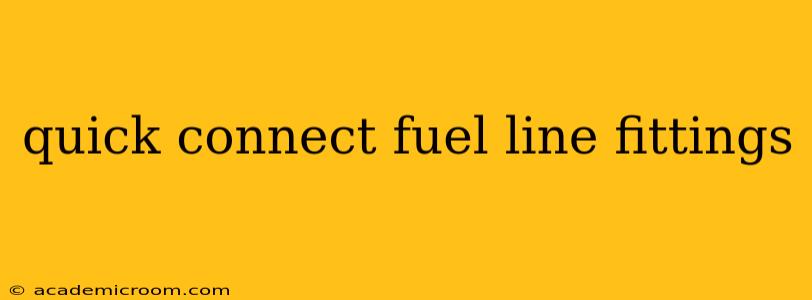Quick connect fuel line fittings are essential components in modern fuel systems, offering a convenient and secure method for connecting and disconnecting fuel lines. Their ease of use and reliability make them a popular choice for various applications, from automobiles and motorcycles to lawnmowers and other small engines. This guide will delve into the specifics of these fittings, addressing common questions and providing valuable information for both professionals and DIY enthusiasts.
What are Quick Connect Fuel Line Fittings?
Quick connect fuel line fittings, also known as push-to-connect or push-fit fuel line connectors, are designed for rapid and secure connection of fuel lines without the need for tools like wrenches or clamps. They typically consist of a male and female connector, where the male end is pushed into the female end, creating a tight seal. The connection mechanism varies depending on the type of fitting, but generally involves a spring-loaded mechanism or a locking ring that secures the connection. The design ensures a leak-proof seal, preventing fuel spillage and ensuring safe operation. Different materials are used depending on the application, with common choices including metal (brass, steel) and plastic (nylon, polypropylene).
How do Quick Connect Fuel Line Fittings Work?
The operation of quick connect fuel line fittings is straightforward. The male end of the fitting is pushed into the female end with a specific amount of force. This action compresses a sealing element (often an O-ring) within the female connector, creating a tight seal that prevents fuel leakage. Disconnection is equally simple; a release mechanism (a tab, button, or collar) is activated, allowing the male fitting to be easily pulled away from the female fitting. This process is typically quick and effortless, saving time and effort compared to traditional clamping methods.
What are the Different Types of Quick Connect Fuel Line Fittings?
There are several types of quick connect fuel line fittings, each designed for specific applications and pressures. These variations stem from differences in their locking mechanisms, materials, and size. Common types include:
- Push-to-connect: The simplest type, relying solely on the force of the connection to create a seal.
- Bayonet style: Utilizes a bayonet-like locking mechanism for a more secure connection.
- Threaded: Combines quick connect features with a threaded connection for added security in high-pressure applications.
- Lever-type: Employs a lever to secure and release the connection.
What are the Advantages of Using Quick Connect Fuel Line Fittings?
Several key advantages make quick connect fuel line fittings a preferred choice in many applications:
- Ease of use: Connections and disconnections are quick and simple, requiring no specialized tools.
- Speed of installation: Installation time is significantly reduced compared to traditional methods.
- Reduced leakage: The tight seal minimizes the risk of fuel leakage, enhancing safety and preventing environmental hazards.
- Versatility: Available in a wide range of sizes and materials to suit different applications.
- Cost-effectiveness: In many cases, the initial cost is offset by the time saved during installation and maintenance.
How to Choose the Right Quick Connect Fuel Line Fitting?
Choosing the appropriate quick connect fuel line fitting requires considering several factors:
- Fuel type: Ensure the fitting is compatible with the specific fuel being used (e.g., gasoline, diesel). Material compatibility is crucial to prevent corrosion or degradation.
- Pressure rating: The fitting's pressure rating must exceed the maximum operating pressure of the fuel system to avoid leaks or failures.
- Hose size: Select a fitting with the correct inside diameter to match the fuel line.
- Application: The type of fitting chosen will depend on the application's specific requirements, such as ease of use, durability, and pressure resistance.
How to Install Quick Connect Fuel Line Fittings?
Proper installation is essential to ensure a secure and leak-proof connection. Always refer to the manufacturer's instructions for specific guidance. General steps include:
- Prepare the fuel lines: Ensure the ends of the fuel lines are clean and free of debris.
- Insert the male fitting: Push the male end firmly into the female end until it clicks into place.
- Check for leaks: Inspect the connection for any signs of leakage.
What are Some Common Problems with Quick Connect Fuel Line Fittings?
While generally reliable, several issues can arise with quick connect fuel line fittings:
- Leaks: This is often caused by improper installation, damage to the sealing element, or using incompatible fittings.
- Difficult connection/disconnection: Worn-out fittings or damage to the locking mechanism can make connection or disconnection difficult.
- Corrosion: Over time, corrosion can affect the performance of the fittings, especially in metal fittings.
Addressing these issues often involves careful inspection, replacement of damaged components, or addressing underlying issues within the fuel system itself.
Remember to always prioritize safety when working with fuel lines. If you are unsure about any aspect of installation or maintenance, it is always best to seek professional assistance.
